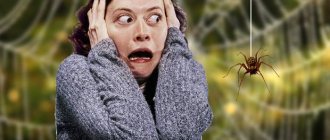.
Since ancient times, people have been wary of snakes. These creatures can be so dangerous that one bite is enough to kill a person. Just because you find walking through swampy forests, mountains or near bodies of water dangerous, does not mean that you have a phobia of snakes. If you experience genuine horror when you see a snake in a terrarium, you are panicked by the snake you see in the picture - these are clear signs of illness.
To find out what name the fear of snakes has, let’s turn to the Greek terminology: fear - “phobos”, snake - “ophidio”.
This disorder is called ophidiophobia. It is one of the sections of herpetophobia, fear of any reptiles.
Ophidiophobia - fear of snakes
How common is herpetophobia?
Specific phobias are a relatively common anxiety disorder.
It is likely that many people will encounter them at some stage in their lives. According to information collected by the National Institute of Mental Health (NIMH), approximately 12.5% of adults will experience some type of phobia at some point ().
Of all reptiles, the fear of snakes is the most common. It is estimated that 2 to 3 percent of people meet clinical criteria for a fear of snakes (ophidiophobia) ().
What causes fear of lizards and snakes?
The factors that cause specific phobias, such as herpetophobia, are currently unclear. However, there are several things that may contribute, including:
Bad experience
A bad experience with a reptile can leave you feeling scared or hurt. For example, a person who is bitten by a snake may develop a fear of snakes.
Education
We may learn to be afraid of certain things, especially at a young age. For example, if you have a parent or sibling who is very afraid of lizards, you can learn to be afraid of them too.
It is also important to note that cultural factors may also play a role in human perception of reptiles. Reptiles, especially snakes, are often found in mythology, folklore, and religious texts around the world.
A 2012 study of 514 participants in Portugal examined attitudes toward reptile and amphibian conservation. Researchers have found that negative impressions or folklore associated with these animals give rise to negative attitudes ().
Genetics
Genetics can also contribute to the development of certain phobias. For example, if one of your parents has a fear of lizards, that fear or increased risk of developing it could potentially be passed on to you ().
Regarding the fear of snakes, humans may have evolved an increased ability to detect these animals. It is believed that this adaptation helped ancient people avoid snake attacks.
A 2014 study examined people's ability to find snakes. Participants were asked to find a snake in a group of distracting background images ().
It was found that participants were able to select pictures of snakes from background images faster and more accurately than pictures of spiders or mushrooms.
Fear
Everyone experiences feelings like anxiety and fear differently. It is possible that some people are naturally more anxious. This may increase the likelihood of developing a phobia.
Causes of fear of snakes
There are five reasons for the development of a phobia:
- Genetic predisposition. The fear of reptiles could have been inherited from our distant ancestors. It is associated with the instinct of survival and self-preservation.
- Personal psychotrauma (meeting with a representative of the species). In 15% of cases, fear is formed after a personal negative experience with a snake. Maybe she bit the person or his friend, or maybe she just really scared him. Or maybe someone was frightened by the horror story that the animal would crawl out of the terrarium, or maybe it really happened.
- Inheritance from parents. If the parents are afraid, and the child saw their reaction, then he will also begin to be afraid of snakes. We can talk about hysteria and panic of parents in front of the child or intimidation for reasons of care.
- Personal characteristics of a person combined with a cruel joke from friends. A harmless prank in the form of throwing a snake (possibly a toy) into a house or bag can result in psychological trauma and phobia. Not only pranks, but also horror films where snakes attack people can affect the psyche.
- Religious Beliefs. In some religions and cultures, the snake is considered a symbol of evil.
There is a common prerequisite for all phobias - hormonal disruptions, disturbances in the functioning of neurotransmitter systems. This happens against the background of mental disorders, alcohol, nicotine and drug addiction, abuse of coffee and energy drinks, long-term and improper use of psychoactive medications. If this is the reason, then medical treatment of the phobia is indicated.
This is interesting! According to Freud, fear of snakes means denial of the masculine principle, fear of violence. The psychoanalyst believed that the ophiphobe associates the snake with a phallic symbol.
Symptoms of fear of reptiles
There are two types of specific symptoms of a phobia: psychological and physical. The main psychological symptom of herpetophobia is a feeling of overwhelming fear or anxiety when in contact with a reptile.
These feelings are often disproportionate to the actual threat the reptile poses to humans. In addition to feeling fear and anxiety in the physical presence of a reptile, a person with herpetophobia may also experience symptoms of the following:
- when thinking about a reptile
- when a person talks or hears other people talk about reptiles
- when viewing pictures or videos of reptiles
A person suffering from herpetophobia will often go out of their way to avoid contact with reptiles. This could potentially cause serious disruption to their daily lives and activities.
People with a specific phobia, such as herpetophobia, may also have physical symptoms. These include:
- increased heart rate
- sweating
- shaking or tremor
- dyspnea
- feeling dizzy, lightheaded, or faint
- chest tightness
- bad feeling in the stomach or nausea
Herpetophobia and children
Children can also have herpetophobia. When a child with herpetophobia encounters a reptile, they may do some of the following things:
- freeze
- start crying
- cling to an adult
- throw a tantrum
Description and manifestation of phobia
Everyone has a fear of reptiles , but some people treat it with humor, while others absolutely cannot fight it and behave irrationally. The lack of this rationality is expressed not only in hysterics, fear, stupor, anxiety at the sight of a snake, but also in anxiety that reptiles will end up in the home. The patient is haunted by obsessive dreams involving them.
Any object that resembles a snake causes horror in a person. Films and paintings with reptiles can put him in a stupor and panic. This is herpetophobia - one of the types of zoophobia.
Manifestations of this phobia vary: from mild to severe. Some people feel discomfort when touching a reptile, but can safely be near it. Others begin to go hysterical at the sight of a photograph of a snake - this is already a severe form.
Some people treat those suffering from this disease with understanding, others with humor and even consider themselves herpetophobes. Others are afraid to be near such patients, because in the presence of reptiles their behavior is unpredictable and inadequate.
The instinct of self-preservation, that is, the usual fear at the sight of a live snake, is not herpetophobia. What are the manifestations of this disease? Fear of reptiles is expressed in the following:
- Intellectually, a person understands that his fear is far-fetched, hyperbolic, that is, exaggerated. He realizes that not everything is so terrible. But at the sight of a reptile, this awareness abruptly disappears. Immediately anxiety, fear and numbness appear, up to a panic attack.
- Deterioration of the general condition: shortness of breath, palpitations, sweating, nausea, increased blood pressure, dizziness, dry mouth, feeling of lack of air.
- While of sound mind, the herpetophobe loses the ability to express thoughts coherently.
- The feeling that death is about to occur.
- Most often, such people are nervous, fussy, irritable, they find it difficult to concentrate, and they get tired quickly.
- In patients with severe manifestations, all of the above symptoms are strongly expressed, and a panic attack can lead to paralysis.
What does fear of reptiles lead to? In fact, this is a very serious disease and over time its consequences only get worse:
- Herpetophobe begins to fear even those objects that are not directly related to reptiles, since certain associations have already formed in his head.
- Far-fetched fantasies and fears. For example, fear of snake attacks.
- Refusal of pleasant things: picnics, trips to pet stores, zoos, exhibitions.
- The inability to lead a full life, up to complete self-isolation in the apartment.
When to see a doctor
If your fear of reptiles begins to seriously interfere with your life, you should seek help from a doctor. Serious negative impacts on a person’s life include:
- decreased productivity at work or school
- strained relationships with family and friends
- influence on social interaction or social activity
- deterioration in your ability to perform daily tasks
If you notice any of these, make an appointment with a psychiatrist. There are many types of mental health professionals, including psychologists and psychiatrists.
During your first visit, they will discuss your medical history and symptoms with you. Based on the information collected, they will recommend a treatment plan. Below we will discuss the treatment of herpetophobia in more detail.
How to get rid of a phobia?
Self-treatment for phobic disorders practically does not bring results. It is advisable for relatives or the patient himself to consult a professional doctor for treatment.
In this case, tablets are used only to eliminate the symptoms of panic attacks and physiological disorders caused by constant stress. The use of medications is advisable if herpetophobia is accompanied by severe physical and mental symptoms.
The main thing in treating any phobia is to eliminate the patient’s obsessive fear. Psychotherapists successfully use the following several methods to achieve this goal:
- Cognitive behavioral psychotherapy.
- NLP practitioners.
- Method of systematic desensitization.
- Hypnosis.
In all cases, the patient is gradually “introduced” to reptiles, controlling and preventing the occurrence of fear. A person gets used to the sight of reptiles, learns to separate truly dangerous situations from unreasonable anxiety.
In addition to undergoing treatment, it is important for the patient to independently fight his false beliefs. It is necessary to study reliable information about snakes and apply the learned techniques in practice when the symptoms of a phobia recur.
A timely visit to a qualified psychotherapist and having your own motivation will help you get rid of herpetophobia once and for all, treat animals calmly and live a full life!
How to cure herpetophobia
Treatment for herpetophobia includes therapy and, less commonly, medication. Let's take a closer look at each treatment option, as well as some general tips for coping.
Therapy
There are two different types of therapy that are often used for certain phobias, such as herpetophobia. This:
- Exposure therapy . Your therapist will gradually increase your exposure to reptiles. For example, he might ask you to think about reptiles in your first session so that you can hold reptiles in your hands in subsequent sessions. Various techniques for dealing with anxiety are also taught.
- Cognitive behavioral therapy (CBT) . The goal of CBT, often used in conjunction with exposure therapy, is to help identify and change the negative thought patterns and emotions that contribute to your fear of reptiles.
Medicines
Benzodiazepines and beta blockers are two examples of medications that may be prescribed to you to treat herpetophobia. However, they are often only prescribed for a short time to help you cope with feelings of anxiety.
Selective serotonin reuptake inhibitors (SSRIs) are also often prescribed for certain phobias ().
Additional Tips
In addition to treating herpetophobia, you can also take a few additional steps:
- Try not to let your phobia ruin your daily life. One way to do this is to not go too far to avoid reptiles.
- Try different ways to reduce stress, such as yoga and meditation.
- Avoid stimulants such as caffeine as they can fuel anxiety.
- Introduce and maintain a healthy lifestyle, such as a well-balanced diet, regular exercise and a regular sleep schedule.
- Don't be shy about telling others how you feel. Joining a support group can help you connect with people in your area who also experience a particular phobia.
How does ophidiophobia manifest itself?
A person who suffers from ophidiophobia, when a critical situation occurs, is “shackled” by fear, screams loudly, calls for help, and tries to move away from the object of fear as far as possible. The person suffering from the disease changes the complexion of his face: it becomes pale or red. There is trembling in the hands, the person gestures vigorously, the timbre of speech changes, his voice trembles, the heart rate increases, shortness of breath appears, the palms begin to sweat, the mouth feels dry, he may feel nauseous, and he feels a general malaise.
People who are afraid of these reptiles try by all means to prevent meeting the object of fear: they do not visit terrariums, try not to look at the section with reptiles in pet stores, are afraid of walking in the forest and walking near water bodies, and refuse to spend the night in tents. The disease can reach very serious proportions: people begin to imagine reptiles in objects with similar shapes (it could be an ordinary belt or a tree branch lying on the ground). Panic may seize an ophidiophobe while watching a television program about snakes, after which it becomes difficult for him to sleep and he has nightmares.
Manifestation of ophidiophobia
Summarize
Herpetophobia is the fear of reptiles. This can include any type of reptile, but the most common are snakes and lizards.
Herpetophobia is a type of anxiety disorder called specific phobia. People suffering from a certain phobia experience severe anxiety towards the object of their fear. They may also have physical symptoms such as a rapid heartbeat, sweating, and trembling.
Herpetophobia can be cured with therapy. If you find that your fear of reptiles is significantly affecting your life, make an appointment with a mental health professional.
Symptoms of fear of reptiles
You can say that you have a pathological fear of snakes if:
- you feel fear when you are directly near a reptile;
- you are unable to be in a pet store that sells reptiles;
- the slightest chance of meeting a snake makes you give up hiking, picnics and other outdoor activities;
- you have an excessive reaction when accidentally encountering any reptile: screaming, crying, tremors, rapid breathing, nausea or vomiting.
With mild herpetophobia, it is possible to stay near a frightening object, but physical contact brings unbearable suffering, and a panic attack develops.
A panic attack becomes truly dangerous when meeting a truly poisonous reptile. A person in such a state does not control his actions, behaves inappropriately and can provoke aggression from the snake.











